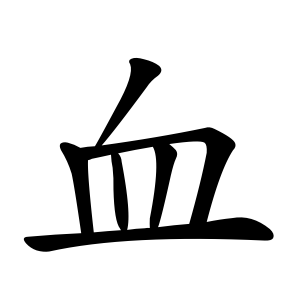血
- blood;
Etymology
The character 血 (meaning "blood") originally referred to the sacrificial blood offered in ancient Chinese rituals. Its form is a pictograph depicting blood collected in a vessel.
In oracle bone script, it appears as a drop of blood falling into a container. Because the vessel's shape is included, it resembles the character 皿 (meaning "vessel" or "dish").
Over time, its meaning expanded to signify the blood of humans and animals, as well as related concepts like lineage or blood relations. When used as a verb, it can mean "to spill blood."
Usage in Korean
The Korean reading "혈" (hyeol) is a rare pronunciation shared by fewer than ten Chinese characters. It was classified as a representative sound in Middle Chinese by Guangyun (小韻).
Although similar-sounding characters exist, 血 overwhelmingly means "blood," which even influenced other characters with originally different initials, causing some to adopt a similar pronunciation due to phonetic contamination rather than direct phonetic derivation.
When used as a semantic component (radical), it generally relates to meanings associated with blood, sacrificial rites, or medicine.
However, the character 衆 (meaning “multitude”)—which is the most frequently used character under this radical—actually does not belong under the blood radical. Its form was mistakenly altered to include 血, so its meaning is unrelated to blood.
Characters with 血
- 竹月廿 (HBT)
- ⿱ 丿 皿
